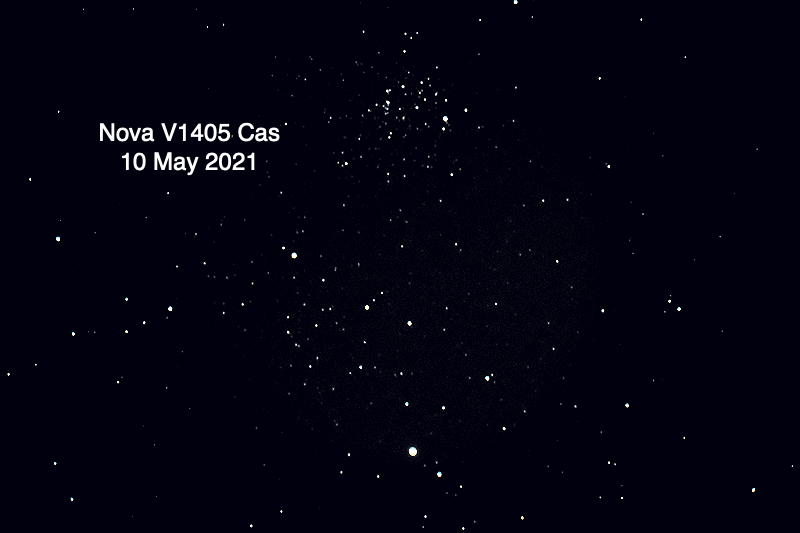Nova V1405 Cassiopeiae
Posted: 11 May 2021
Saturday night, 8 May 2021, I was at Oracle State Park. The Arizona Office of Tourism was there to highlight the Park as the first park in the Arizona State Parks & Trails system to be designated (in 2014) as an IDA "International Dark Sky Park". It was a beautiful night with some telescopes set up by the Tucson Amateur Astronomy Association and the Saddlebrooke SkyGazers Club. I measured a SQM reading of 21.43 at the Park.


Sunday, 9 May, was clear and windy (again). So was Monday, 10 May. The wind was forecast to calm down after sunset on Monday so I opened the observatory.
|
Open: Monday, 10 May 2021, 1828 MST Temperature: 85°F |
Session: 1634 Conditions: Clear, windy |
Equipment:
12" f/8 LX600 w/StarLock
2" 24mm UWA eyepiece
Focal Reducer
Camera:
D850 DSLR
SYNCed observatory clock to WWV time signals.
Set up the D850 DSLR with a 14mm UWA lens on the observatory patio to photograph a pass of Starlink satellites from the 4 May 2021 launch from Florida.

I then relaxed on the observatory patio bench.
1916 MST: sunset.
1917 MST: LX600 ON, StarLock OFF, High Precision OFF.
1918 MST: viewed Venus, 102X. Venus was higher in the sky this evening than on the previous sessions. A nearly full phase was visible. Then viewed Mercury, 102X. A half-phase was visible.
Slewed the 12" telescope to M52 (open star cluster) in the constellation of Cassiopeia. I hoped to observatory Nova V1405 Cassiopeiae, which had brightened in recent nights. Unfortunately, Cassiopeia would be very low in the northern sky.
1925 MST: back to the bench to watch the stars come out. Calmer now.
2000 MST: prepared for the Starlink pass. The satellites were predicted to be Mag. +3-ish during the pass 2015-2020 MST. However, no Starlink satellites were seen in the still somewhat bright twilight sky and none were photographed. Mag. +3 and +4 stars were visible so some satellites should have been seen. Photographically, stars of fainter magnitude were captured so the Starlink satellites were much fainter than predicted. That's a good thing.
2028 MST: calm now. Viewed Nova V1405 Cassiopeiae, about Mag. +5.5, in the same field-of-view as M52, 102X. It was definitely much brighter than the last time I observed it.
Mounted the D850 DSLR at prime focus + focal reducer, focused on the star Capella, locked the 12" primary mirror, and slewed back to M52.
2040 MST: StarLock ON.
I was surprised that the Starlock was able to lock onto a guide star so low in the sky.
I took this Starlock autoguided image of Nova V1405 Cassiopeiae and M52 (open cluster), 30 seconds, ISO 25600. North and M52 are at the top.

Mouseover or tap on image for label
Compare the above image to this one from 21 March. North is at the right.

2048 MST: StarLock OFF.
Viewed M13 (Great Globular Cluster in Hercules), 102X.
2106 MST: LX600 OFF.
2115 MST: took a Sky Quality reading and reported the result to Globe at Night.
|
Close: Monday, 10 May 2021, 2119 MST Temperature: 67°F |
Session Length: 2h 51m Conditions: Clear, SQM 21.14 |
Comments are welcome using Email. Twitter users can use the button below to tweet this report to their followers. Thanks.
Cassiopeia Observatory Home Page
Copyright ©2021 Michael L. Weasner / mweasner@me.com
URL = http://www.weasner.com/co/Reports/2021/05/11/index.html
